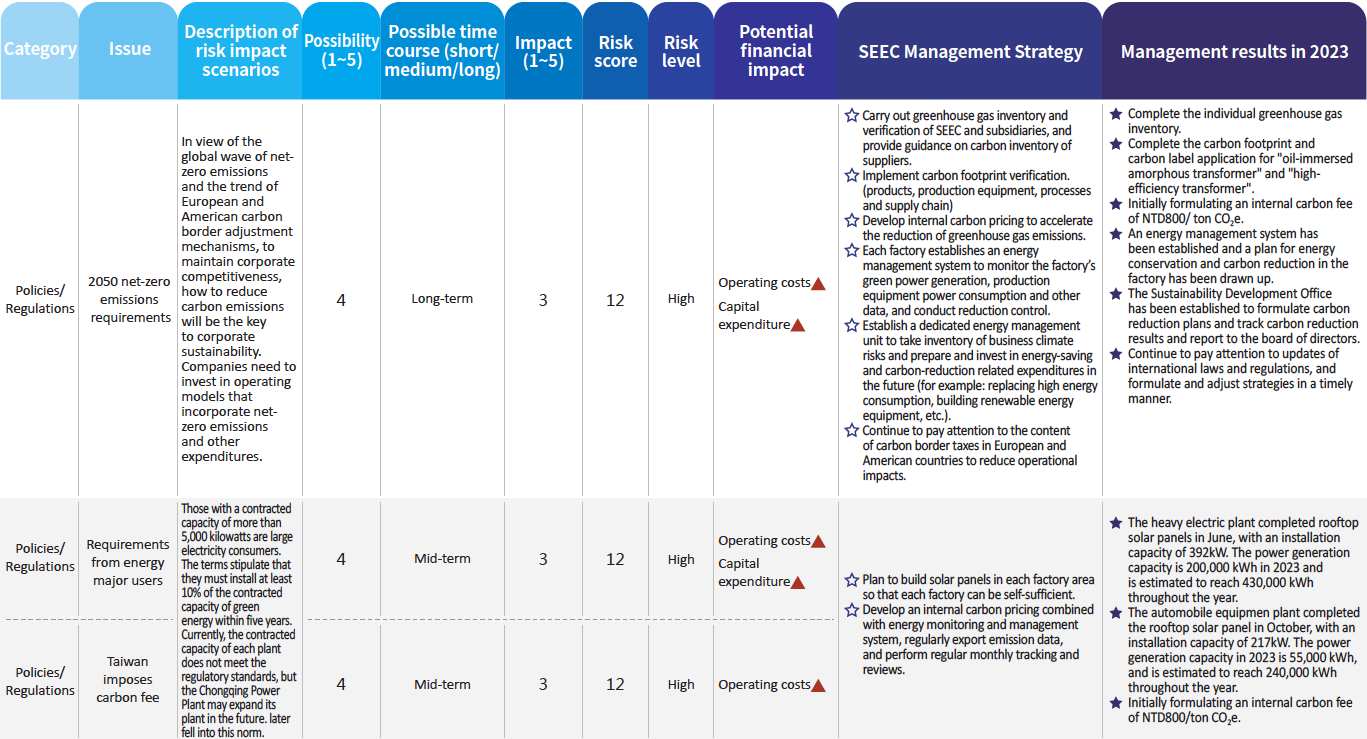Climate Change Management
Domestic and foreign countries are increasingly paying attention to the impact of extreme weather caused by global climate change. The Company refers to the Task Force on Climate-Related Financial Disclosures, TCFD, issued by the International Financial Stability Board (FSB), to disclose climate change-related information and develop corresponding response measures based on disclosure frameworks such as "Governance", "Strategy", "Risk Management", "Indicators and Targets"
Governance
In May 2023, the board of directors officially approved the establishment of the "Sustainable Development Committee". The committee is composed of all independent directors. The Sustainability Development Department , which is under the Sustainability Development Committee, is supervised and managed by Chief Sustainability Officer. It focuses on environmental protection (E), The three major aspects of social participation (S) and business governance (G) are divided into six working groups to promote ESG tasks.
The company held a board of directors and sustainable development committee meeting on November 8, 2023, to report on ESG key indicator tracking, carbon inventory results as of the third quarter of 2023, and carbon reduction plans from 2023 to 2030. At the same time, it is planned to introduce the company's internal carbon fee system and energy management system in 2024 to accelerate the promotion of carbon reduction actions such as green energy and energy conservation.
TCFD Risk and Opportunity Assessment Management
The company held a TCFD risk opportunity identification meeting on December 7, 2023. The ESG report preparation team, led by the Chief of Corporate Governance and Deputy General Manager Shih, Chin-Yi, focused on the transformation risks in TCFD (policies and regulations, technology, market, reputation), Discuss and evaluate the sources of physical risks (immediate, long-term) and opportunities (resource efficiency, energy sources, products/services, markets, resilience).
In 2023, the TCFD risk assessment included 15 risk issues such as the Carbon Border Adjustment Tax, 2050 Net-Zero Emission Requirements, Energy Major User Requirements, Water Usage Fees, Mandatory Reporting Requirements, and Carbon Tax Levies. TCFD opportunities included 9 items such as low-carbon product and service opportunities, use of low-carbon energy, and entry into new markets. SEEC conducted impact scenario and risk level assessments from various perspectives including future business development strategies, green energy layout, stakeholder interests, and regulatory requirements. The company discussed the likelihood of occurrence, the expected timing of impact, and the extent of financial impact on SEEC for each risk and opportunity, and assigned risk scores accordingly. SEEC prioritized discussions on response strategies for the top 5 risks and 5 opportunities based on their impact levels, using these discussions as references for adjustments to operational strategies.
TCFD Risks and Opportunities Countermeasures and Responses
Key Climate Risk Issues and Response Strategies
Assessment of the Financial Impact Of Climate Change
SEEC Introduces Internal Carbon Pricing Mechanism
In order to accelerate the achievement of energy conservation and carbon reduction goals and respond to the risks and threats brought by TCFD, SEEC introduced an internal carbon fee mechanism for the first time in 2023. This mechanism refers to factors such as the international carbon tax system (such as the practices of the European Union and the United States), the carbon pricing model of benchmark companies, prices in the carbon emissions trading market, and fines in relevant regulations. At the same time, taking into account the domestic and foreign sales of each business unit, the company has set an internal carbon price at NT$800 per ton, which is expected to be included in the operating report for monthly tracking to supervise implementation.
Our internal carbon pricing mechanism encourages each business unit to conduct a monthly inventory of emissions, and include it in the financial management statements at an internal price of NT$800 per ton as an outside expense of the business unit, further linking emissions with business performance of each business unit. This design encourages each business group to continue to actively develop energy-saving products and promote green energy projects and other measures. At the same time, the company is committed to the use of green energy, the introduction of energy-saving measures and the reduction of greenhouse gas emissions in each factory area, aiming to achieve SEEC carbon reduction goals and enhance corporate image.
KPIs and Goals
Renewable Energy
According to statistics, electricity consumption is the our main source of carbon emissions. Currently, the contracted capacity of each plant does not meet regulatory standards. However, Heavy Electric plants may fall within this standard after future expansion. In response to ESG (carbon reduction production) and government green energy policies, the company plans to build and use 10% green electricity, and actively increases the capacity of solar installations, with the goal of increasing the proportion of green electricity usage to 15% by 2030.
Under on-going planning, the first phase of solar power generation capacity is expected to reach 1,896kW
Contact:Sustainable Development Division ESG@seec.com.tw



